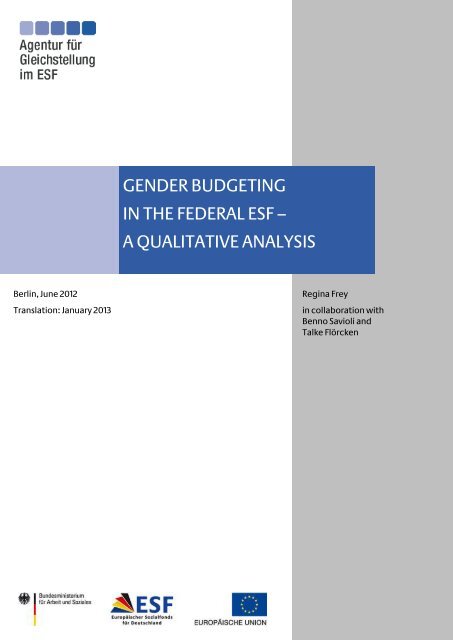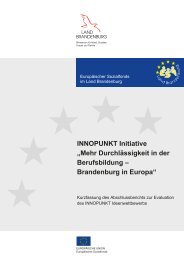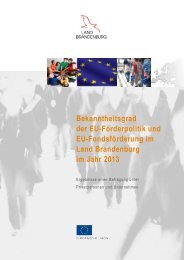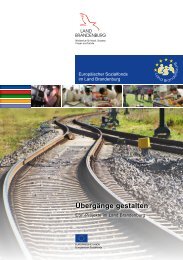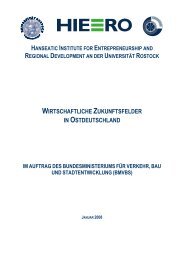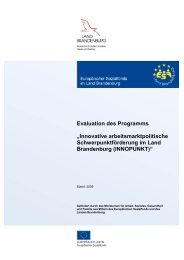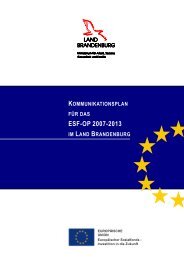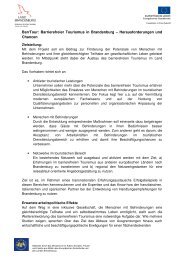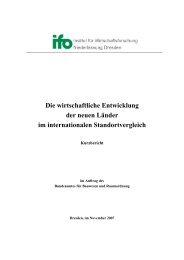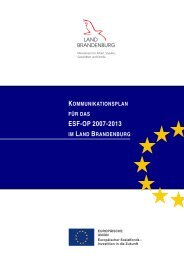gender budgeting in the federal esf – a qualitative analysis
gender budgeting in the federal esf – a qualitative analysis
gender budgeting in the federal esf – a qualitative analysis
You also want an ePaper? Increase the reach of your titles
YUMPU automatically turns print PDFs into web optimized ePapers that Google loves.
Berl<strong>in</strong>, June 2012<br />
Translation: January 2013<br />
GENDER BUDGETING<br />
IN THE FEDERAL ESF <strong>–</strong><br />
A QUALITATIVE ANALYSIS<br />
Reg<strong>in</strong>a Frey<br />
<strong>in</strong> collaboration with<br />
Benno Savioli and<br />
Talke Flörcken<br />
1
Agentur für Gleichstellung im ESF<br />
CONTENTS<br />
1 Introduction ...................................................................................................................................... 2<br />
1.1 Methodology............................................................................................................................. 2<br />
2 Results of <strong>the</strong> <strong>analysis</strong> ....................................................................................................................... 6<br />
2.1 Programme: Bus<strong>in</strong>ess Consult<strong>in</strong>g .............................................................................................7<br />
2.2 Programme: Exist start-up culture ...........................................................................................7<br />
2.3 Programme: Learn to work <strong>–</strong> develop skills <strong>–</strong> <strong>the</strong> ability to <strong>in</strong>novate <strong>in</strong> an modern work<br />
environment .............................................................................................................................. 9<br />
2.4 Programme: Job Initiative ........................................................................................................ 9<br />
2.5 Programme: Service Network for Tra<strong>in</strong><strong>in</strong>g <strong>in</strong> Care of <strong>the</strong> Elderly ........................................ 10<br />
3 Conclusion ........................................................................................................................................ 11<br />
4 Sources and literature ..................................................................................................................... 13<br />
4.1 Sources analysed ...................................................................................................................... 15<br />
5 Addendum ....................................................................................................................................... 17<br />
5.1 Programme overview .............................................................................................................. 17<br />
5.2 Table Index ............................................................................................................................... 18<br />
1
Agentur für Gleichstellung im ESF<br />
1 INTRODUCTION<br />
In <strong>the</strong> <strong>federal</strong> Operational Programme (OP) of <strong>the</strong> European Social Fund (ESF), <strong>gender</strong> <strong>budget<strong>in</strong>g</strong> is<br />
applied a) <strong>in</strong> <strong>the</strong> participatory programmes as well as b) <strong>in</strong> <strong>the</strong> projects funded under Code 69 (and<br />
<strong>the</strong>refore explicitly <strong>in</strong>tended as equal opportunity measures). The <strong>analysis</strong> for 2010 revealed that of<br />
<strong>the</strong> 62 programmes that were <strong>in</strong>cluded <strong>in</strong> <strong>the</strong> monitor<strong>in</strong>g system ADELE, 32 programmes <strong>in</strong>dicated<br />
participation and expenditures and could <strong>the</strong>refore be <strong>in</strong>corporated <strong>in</strong>to <strong>the</strong> quantitative <strong>gender</strong><br />
<strong>budget<strong>in</strong>g</strong> <strong>in</strong> accordance with <strong>the</strong> OP. In addition, non-participatory projects that received fund<strong>in</strong>g<br />
under Code 69 were also <strong>in</strong>cluded. Here an important result is that <strong>the</strong> percentage of funds that<br />
were allocated to women or to equal-opportunity-oriented projects (calculated at two-thirds) was<br />
43,7 percent up to 2010. The target goal <strong>in</strong>dicated <strong>in</strong> <strong>the</strong> OP is at least 50 percent. 1<br />
In order not to limit <strong>the</strong> <strong>analysis</strong> to this part of <strong>the</strong> Operational Programme, <strong>the</strong> Agency for Equality<br />
with<strong>in</strong> <strong>the</strong> ESF suggested a <strong>qualitative</strong> application of <strong>gender</strong> <strong>budget<strong>in</strong>g</strong> that is not concerned with<br />
<strong>the</strong> quantitative fund<strong>in</strong>g allocation among men and women (participation), but ra<strong>the</strong>r with what is<br />
expected with regards to content, namely <strong>the</strong> contribution to equality. This approach of <strong>the</strong><br />
“Equality Portfolio” <strong>in</strong>cludes a classification of all funded activities accord<strong>in</strong>g to <strong>the</strong>ir potential for<br />
affect<strong>in</strong>g equality outcomes and <strong>the</strong> l<strong>in</strong>kage of <strong>the</strong> (<strong>qualitative</strong>) classification with <strong>the</strong> implementted<br />
budget. This represents a broaden<strong>in</strong>g of <strong>the</strong> <strong>gender</strong> <strong>budget<strong>in</strong>g</strong> approach beyond <strong>the</strong> <strong>analysis</strong><br />
of projects and activities based on participation. In this way, <strong>qualitative</strong> <strong>gender</strong> <strong>budget<strong>in</strong>g</strong> can<br />
advance a better representation of estimated equality for <strong>the</strong> OP as a whole. At this po<strong>in</strong>t it should<br />
be noted that <strong>the</strong> <strong>qualitative</strong> <strong>gender</strong> <strong>budget<strong>in</strong>g</strong> draws upon <strong>the</strong> expected equality outcomes <strong>–</strong><br />
here, <strong>the</strong>refore, it is <strong>the</strong> potential equality outcome of programmes that is be<strong>in</strong>g estimated. In<br />
contrast, with quantitative <strong>gender</strong> <strong>budget<strong>in</strong>g</strong>, fund<strong>in</strong>g recipients were or are evaluated only <strong>in</strong><br />
retrospect. Thus <strong>qualitative</strong> <strong>gender</strong> <strong>budget<strong>in</strong>g</strong> offers ongo<strong>in</strong>g programmes <strong>the</strong> possibility to adopt<br />
a political equality orientation. For programmes already concluded <strong>in</strong> this fund<strong>in</strong>g period, subsequent<br />
applications offer assessments of possible equality outcomes as well as guidance for <strong>the</strong><br />
design of follow-up programmes.<br />
1.1 METHODOLOGY<br />
The assessment and <strong>the</strong> rank<strong>in</strong>g of <strong>the</strong> non-participatory programmes accord<strong>in</strong>g to probable equality<br />
outcomes <strong>in</strong>itially requires a classification of <strong>the</strong> expected equality outcomes:<br />
Tab. 1: Suggested Classification: Rank<strong>in</strong>g Categories and <strong>the</strong>ir Statistical Weight<br />
Category Statistical Weight Factor<br />
Explicitly aimed at equality (G + 2) + 2<br />
Probable positive equality outcome (G + 1) + 1<br />
No impact on <strong>the</strong> equality situation (Initial position) (G0) 0<br />
Negative equality outcome is possible or is to be expected (G-1) - 1<br />
1<br />
Compare Frey / Savioli / Agentur für Gleichstellung im ESF (Hg) 2011, http://www.<strong>esf</strong>gleichstellung.de/fileadm<strong>in</strong>/data/Downloads/Aktuelles/<strong>gender</strong>-<strong>budget<strong>in</strong>g</strong>-bericht-2010_agentur_gleichstellung_<strong>esf</strong>.pdf<br />
Fur<strong>the</strong>r results <strong>in</strong>clude: The percentage of funds that were allocated to women or to equality-oriented<br />
projects (calculated at two-thirds) <strong>in</strong>creased by 2,3 percentage po<strong>in</strong>ts from 2009 (41,4 percent) to 2010<br />
(43,7 percent). At <strong>the</strong> same time, <strong>the</strong> f<strong>in</strong>ancial volume of <strong>the</strong> projects focussed specifically on equality sank by<br />
one percentage po<strong>in</strong>t, from 6,2 percent to 5,2. An <strong>in</strong>crease <strong>in</strong> <strong>the</strong> differences can also be observed <strong>in</strong> <strong>the</strong> per<br />
capita costs.<br />
2
Agentur für Gleichstellung im ESF<br />
The content of <strong>the</strong>se categories will be differentiated as follows:<br />
Category Criterium<br />
Explicitly aimed at<br />
equality (G + 2)<br />
The follow<strong>in</strong>g criteria are fulfilled:<br />
Accord<strong>in</strong>g to its def<strong>in</strong>ed goals, <strong>the</strong> programme is aimed directly at and has<br />
as its ma<strong>in</strong> goal <strong>the</strong> equality of women and men:<br />
a) <strong>in</strong> <strong>the</strong> timetable for <strong>the</strong> equality of women and men 2006-2010 and/or<br />
b) <strong>in</strong> <strong>the</strong> strategy for <strong>the</strong> equality of women and men 2010-2015 and/or<br />
c) <strong>in</strong> <strong>the</strong> NSRP and/or<br />
d) <strong>in</strong> <strong>the</strong> OP.<br />
These criteria are clearly evident <strong>in</strong> <strong>the</strong> programme goals, <strong>the</strong> guidel<strong>in</strong>es<br />
and <strong>the</strong> selection criteria as well as <strong>in</strong> <strong>the</strong> public relations of <strong>the</strong><br />
programme.<br />
Based on <strong>the</strong> projects eligible for fund<strong>in</strong>g and implementation structures<br />
of <strong>the</strong> programme, <strong>the</strong> expectation is that <strong>the</strong> goals formulated for <strong>the</strong><br />
programme will be fulfilled.<br />
Probable positive equality The follow<strong>in</strong>g criteria are fulfilled:<br />
outcome (G + 1)<br />
· A concrete contribution to one or more equality goal/s with regard to<br />
target groups or subsidised content is def<strong>in</strong>ed.<br />
· Selection criteria for <strong>the</strong> project conta<strong>in</strong>s a mean<strong>in</strong>gful and functional<br />
reference to equality.<br />
· The guidel<strong>in</strong>es and <strong>the</strong> selection criteria as well as <strong>the</strong> public relations of<br />
<strong>the</strong> programme realise this objective.<br />
· Equality/equal opportunity <strong>in</strong>fluence decisions concern<strong>in</strong>g <strong>the</strong> selection of<br />
s<strong>in</strong>gle projects.<br />
No impact on <strong>the</strong> equality The follow<strong>in</strong>g criteria are fulfilled:<br />
situation (Initial position) · The guidel<strong>in</strong>es of <strong>the</strong> programmes ensure that women and men profit from<br />
(G0)<br />
<strong>the</strong> programme accord<strong>in</strong>g to <strong>the</strong>ir start<strong>in</strong>g positions.<br />
· The programme documents and public relations materials make it clear<br />
that sex-related direct barriers are addressed with<strong>in</strong> <strong>the</strong> framework of <strong>the</strong><br />
programme.<br />
· It is evident, that <strong>the</strong> programme, with<strong>in</strong> its sphere of <strong>in</strong>tervention,<br />
assumes neutrality with regard to sex. Equality and equal opportunity are<br />
claimed, but not actively implemented <strong>in</strong> <strong>the</strong> execution of <strong>the</strong> programme.<br />
Negative equality<br />
outcome is possible or is<br />
to be expected (G-1)<br />
The follow<strong>in</strong>g criteria are fulfilled:<br />
· The programme management documentation (guidel<strong>in</strong>es, selection<br />
criteria) makes no reference to equality and/or equal opportunity.<br />
· It cannot be assumed that <strong>the</strong> design of <strong>the</strong> programme and/or its criteria<br />
for fund<strong>in</strong>g will not pose <strong>in</strong>direct barriers to access for women.<br />
· The public relations materials do not address equality or equal<br />
opportunity; <strong>the</strong> language and visuals used are supposedly neutral with<br />
regard to sex or portray sex-role stereotypes.<br />
· The sett<strong>in</strong>g of priorities/orientation of <strong>the</strong> programme reflects <strong>the</strong> already<br />
exist<strong>in</strong>g segregation of <strong>the</strong> job market and could help re<strong>in</strong>force it.<br />
By means of <strong>the</strong>se four categories, <strong>the</strong> anticipated activities could be ranked accord<strong>in</strong>g to <strong>the</strong>ir<br />
estimated political equality outcome on a scale of -1 to +2 and <strong>the</strong> funds apportioned to each could<br />
be correspond<strong>in</strong>gly weighted. Equality-neutral projects that merely reproduce already-exist<strong>in</strong>g<br />
3
Agentur für Gleichstellung im ESF<br />
sex-based conditions and do not contribute to equality were valued at 0 and projects that were<br />
markedly positive for equality with <strong>the</strong> factor 2. 2<br />
This method of evaluation and calculation offers a simple, <strong>in</strong>tuitively comprehensible <strong>in</strong>dicator<br />
accord<strong>in</strong>g to <strong>the</strong> formula:<br />
By which:<br />
Rg = ∑<br />
Rg = <strong>the</strong> total result of <strong>the</strong> rat<strong>in</strong>g of <strong>the</strong> programme <strong>in</strong> question,<br />
i (= 1 to n) for <strong>the</strong> <strong>in</strong>dex of <strong>the</strong> respective s<strong>in</strong>gle programme <strong>in</strong>corporated <strong>in</strong>to <strong>the</strong><br />
evaluation Pi,<br />
V(i) for <strong>the</strong> respectively apportioned volume of funds,<br />
r(i) for <strong>the</strong> programme-specific rat<strong>in</strong>g result (= respective statistical weight factor) and<br />
Vg for <strong>the</strong> correspond<strong>in</strong>g (unweighted) total volume of <strong>the</strong> programme <strong>in</strong> question.<br />
The formula thus determ<strong>in</strong>es <strong>in</strong> each case <strong>the</strong> relationship of <strong>the</strong> weighted (by means of <strong>the</strong> rat<strong>in</strong>g<br />
result) f<strong>in</strong>ancial volume of a s<strong>in</strong>gle programme Pi to <strong>the</strong> unweighted total volume of all <strong>in</strong>cluded<br />
programmes and adds <strong>the</strong>se across all programmes under exam<strong>in</strong>ation. A value larger than 0<br />
<strong>in</strong>dicates a positive, a value under 0 <strong>in</strong>dicates a negative equality outcome. The higher <strong>the</strong> fund<strong>in</strong>g<br />
allotment of a programme, <strong>the</strong> greater its <strong>in</strong>fluence on <strong>the</strong> total equality outcome, and <strong>the</strong> better<br />
<strong>the</strong> rat<strong>in</strong>g, <strong>the</strong> more positive <strong>the</strong> total result (and vice versa).<br />
Compar<strong>in</strong>g <strong>the</strong> sums of <strong>the</strong> funds weighted <strong>in</strong> this way with <strong>the</strong> unweighted total funds it is easy to<br />
observe whe<strong>the</strong>r an overall positive or negative equality outcome is to be expected. For a completely<br />
equality-neutral OP an equality outcome of zero would result; <strong>the</strong> same would be <strong>the</strong> case<br />
for an entire programme <strong>in</strong> which <strong>the</strong> funds were evenly divided between (assumedly) positive and<br />
(assumedly) negative measures.<br />
It should be borne <strong>in</strong> m<strong>in</strong>d that <strong>the</strong> present report encompasses five of a total of 24 non-participatory<br />
programmes (compare <strong>the</strong> overview <strong>in</strong> <strong>the</strong> attachment, p. 45). Of <strong>the</strong>se 24 programmes, six<br />
programmes are <strong>in</strong> turn funded under Code 69 (explicitly aimed at equality). When it is assumed<br />
that <strong>the</strong>se programmes fall <strong>in</strong>to <strong>the</strong> category G+2, <strong>the</strong> rema<strong>in</strong><strong>in</strong>g 13 programmes must be analysed<br />
<strong>in</strong> order to establish a total value for <strong>the</strong> Operational Programme.<br />
From <strong>the</strong> criteria described above, <strong>the</strong> follow<strong>in</strong>g questions for <strong>analysis</strong> for <strong>the</strong> evaluation of <strong>the</strong>se<br />
five programmes can be derived:<br />
Are concrete equality goals named <strong>in</strong> <strong>the</strong> guidel<strong>in</strong>es?<br />
Do <strong>the</strong> selection criteria refer to <strong>the</strong> equality of women and men?<br />
Does <strong>the</strong> programme description dist<strong>in</strong>guish target groups accord<strong>in</strong>g to sex and/or o<strong>the</strong>r<br />
characteristics?<br />
2<br />
The choice to absta<strong>in</strong> from a completely symmetrical categorisation by <strong>in</strong>clud<strong>in</strong>g ‘Explicitly negative for<br />
equality’ with a correspond<strong>in</strong>g statistical weight factor (-2) is based on <strong>the</strong> pragmatic consideration that such<br />
a category -- even when possibly warranted <strong>in</strong> isolated cases -- would practically not be used <strong>in</strong> <strong>the</strong> process of<br />
evaluation and subsidisation.<br />
4
Agentur für Gleichstellung im ESF<br />
Do supportive measures aimed at equality or equal opportunity exist or will <strong>the</strong>y be<br />
established?<br />
Are contributions to equality or equal opportunity given concrete valuation <strong>in</strong> <strong>the</strong> selection of<br />
s<strong>in</strong>gle projects?<br />
Do <strong>the</strong> public relations materials <strong>in</strong>dicate that equality / equal opportunity is a goal?<br />
When applicable: What statements can be made about <strong>the</strong> evaluation of <strong>the</strong> cross-sectional<br />
goals of <strong>gender</strong> equality and equal opportunity?<br />
The follow<strong>in</strong>g sources were consulted <strong>in</strong> <strong>the</strong> <strong>analysis</strong>:<br />
1. Programme management documentation (guidel<strong>in</strong>es, selection criteria)<br />
2. Public relations materials (flyers, websites)<br />
3. Interview with <strong>the</strong> programme manager or o<strong>the</strong>r person with exact knowledge of <strong>the</strong><br />
programme.<br />
5
Agentur für Gleichstellung im ESF<br />
2 RESULTS OF THE ANALYSIS<br />
In <strong>the</strong> first step, five programmes were selected for model analyses, so that <strong>the</strong> Operational<br />
Programme (OP) has not been completely exam<strong>in</strong>ed up to this po<strong>in</strong>t. Criteria for <strong>the</strong> selection<br />
were: Various priorities, target groups, and subject matter as well as all of <strong>the</strong> responsible departments<br />
should be <strong>in</strong>cluded, and programmes with f<strong>in</strong>ancial endowments <strong>in</strong> <strong>the</strong> higher range as well<br />
as <strong>in</strong> <strong>the</strong> lower range should be taken <strong>in</strong>to account.<br />
The monitor<strong>in</strong>g system supplied data on <strong>the</strong> volume of <strong>the</strong> programmes. Under consideration here<br />
are <strong>the</strong> actual expenditures from <strong>the</strong> beg<strong>in</strong>n<strong>in</strong>g of 2007 (beg<strong>in</strong>n<strong>in</strong>g of <strong>the</strong> fund<strong>in</strong>g period) up until<br />
<strong>the</strong> deadl<strong>in</strong>e for <strong>the</strong> yearly report for <strong>the</strong> fund<strong>in</strong>g year 2010. That is to say, it is not <strong>the</strong> funds committed<br />
but ra<strong>the</strong>r <strong>the</strong> actual expenditures that are <strong>in</strong>cluded. Due to <strong>the</strong> varied durations of <strong>the</strong><br />
analysed programmes (some of which have already ended and some of which are still runn<strong>in</strong>g), this<br />
<strong>analysis</strong> is only an <strong>in</strong>itial snapshot. A full picture is only possible when ...<br />
a) ... all non-participatory programmes are <strong>in</strong>cluded <strong>in</strong> <strong>the</strong> <strong>analysis</strong> and ...<br />
b) ... at <strong>the</strong> end of <strong>the</strong> fund<strong>in</strong>g period, <strong>the</strong> actual expenditures for <strong>the</strong> entire duration of <strong>the</strong><br />
programme can be collected.<br />
Tab. 2: Selected Programmes for Model Analysis<br />
Nr. Programme<br />
1<br />
2<br />
3<br />
Bus<strong>in</strong>ess<br />
Consult<strong>in</strong>g<br />
EXIST Start-Up<br />
Culture<br />
Learn to Work -<br />
Develop Skills -<br />
The Ability to<br />
Innovate <strong>in</strong> a<br />
Modern Work<br />
Environment<br />
Department<br />
PA<br />
BMWi A<br />
BMWi A<br />
Subject<br />
matter<br />
bus<strong>in</strong>ess<br />
promotion /<br />
post-formation<br />
acquisition<br />
start-ups out of<br />
academia<br />
BMBF B <strong>in</strong>novation<br />
4 Initiative JOB BMAS C disability<br />
5<br />
Service Network<br />
for Tra<strong>in</strong><strong>in</strong>g <strong>in</strong><br />
Care of <strong>the</strong> Elderly<br />
BMFSFJ C<br />
elder care,<br />
tra<strong>in</strong><strong>in</strong>g<br />
Target Group Duration<br />
small and<br />
medium-sized<br />
bus<strong>in</strong>esses<br />
universities/rese<br />
arch <strong>in</strong>stitutes<br />
bus<strong>in</strong>esses,<br />
employees,<br />
management<br />
and labour<br />
bus<strong>in</strong>esses and<br />
persons with<br />
disabilities<br />
managers <strong>in</strong><br />
care facilities for<br />
<strong>the</strong> elderly<br />
07/2008<strong>–</strong><br />
12/2013<br />
Volume up<br />
to 2010*<br />
75.040.847 €<br />
2007-2013 10.117.062 €<br />
2006-<br />
2010<br />
41.624.557 €<br />
2007-2010 714.959 €<br />
2007-2010 2.947.118 €<br />
* Source: “ADELE” monitor<strong>in</strong>g system, cut-off date is <strong>the</strong> yearly report for <strong>the</strong> fund<strong>in</strong>g year 2010.<br />
In <strong>the</strong> follow<strong>in</strong>g discussion, <strong>the</strong>se five programmes will be exam<strong>in</strong>ed with regard to <strong>the</strong> visibility of<br />
<strong>gender</strong> ma<strong>in</strong>stream<strong>in</strong>g, and on <strong>the</strong> basis of <strong>the</strong>se results, <strong>the</strong> expected equality performance will<br />
be estimated:<br />
In <strong>the</strong> first step, each of <strong>the</strong> five programmes will be briefly <strong>in</strong>troduced. The description of pr<strong>in</strong>cipal<br />
<strong>gender</strong> aspects <strong>in</strong> <strong>the</strong> fund<strong>in</strong>g area provides, <strong>in</strong> <strong>the</strong> second step, <strong>the</strong> basis for a later estimation of<br />
<strong>the</strong> expected equality outcome. In <strong>the</strong> third step, <strong>the</strong> most important management documents for<br />
6
Agentur für Gleichstellung im ESF<br />
each of <strong>the</strong> five programmes -- programme description, guidel<strong>in</strong>es, selection criteria, and also<br />
public relations materials -- will be analysed: The Information Boxes provide textual support<strong>in</strong>g<br />
documents and references that have been used to formulate <strong>the</strong> respective estimates. Information<br />
drawn from <strong>in</strong>terviews will also be provided here.<br />
At <strong>the</strong> end of each chapter, <strong>the</strong>se partial estimates will be consolidated <strong>in</strong> a conclusion.<br />
2.1 PROGRAMME: BUSINESS CONSULTING<br />
The goal of <strong>the</strong> programme Bus<strong>in</strong>ess Consult<strong>in</strong>g is to create a systems of <strong>in</strong>centives by which a<br />
small or medium-sized bus<strong>in</strong>ess (KMU) or self-employed person can “make use of external knowhow.<br />
The goal is to improve <strong>the</strong> performance and competitive ability of medium-sized bus<strong>in</strong>esses<br />
and to facilitate <strong>the</strong>ir ability to adapt to economic changes. Fund<strong>in</strong>g will support counsell<strong>in</strong>g <strong>in</strong> all<br />
questions relat<strong>in</strong>g to management, work and environmental protection, <strong>the</strong> implementation of<br />
family-friendly programmes <strong>in</strong> <strong>the</strong> company as well as for entrepreneurs.” 3<br />
Target groups are <strong>the</strong> exist<strong>in</strong>g KMU of <strong>the</strong> bus<strong>in</strong>ess economy as well as self-employed professionals.<br />
To def<strong>in</strong>e bus<strong>in</strong>ess owners with migration background as a special target group makes sense <strong>in</strong><br />
consideration of <strong>the</strong> equality situation <strong>in</strong> <strong>the</strong> fund<strong>in</strong>g area (see chapter above, “Pr<strong>in</strong>cipal Gender<br />
Aspects <strong>in</strong> <strong>the</strong> Fund<strong>in</strong>g Area”). Through <strong>the</strong> programme it becomes apparent that a political<br />
equality-oriented sett<strong>in</strong>g of priorities and management is possible and mean<strong>in</strong>gful also <strong>in</strong> <strong>the</strong> field<br />
of bus<strong>in</strong>ess promotion. In this way, <strong>the</strong> programme dist<strong>in</strong>guishes itself positively, <strong>in</strong> terms of hav<strong>in</strong>g<br />
an active equality strategy, from o<strong>the</strong>r programmes <strong>in</strong> which a more sex-neutral approach is taken.<br />
Due to <strong>the</strong> specific appeal to and concrete encouragement for women, an positive equality outcome<br />
can be clearly expected overall.<br />
2.2 PROGRAMME: EXIST START-UP CULTURE<br />
The programme is l<strong>in</strong>ked to <strong>the</strong> programme “EXIST Start-up Stipend”. This programme awards<br />
stipends to s<strong>in</strong>gle persons or research teams. On <strong>the</strong> basis of <strong>the</strong> participatory element, <strong>the</strong> programme<br />
was <strong>in</strong>cluded <strong>in</strong> ESF monitor<strong>in</strong>g. The <strong>gender</strong> <strong>budget<strong>in</strong>g</strong> report on <strong>the</strong> fund<strong>in</strong>g year 2010<br />
revealed a percentage of women of 14,9 percent and a percentage of <strong>the</strong> programme expenditures<br />
of 16 percent.<br />
By this means, <strong>the</strong> programme “Start-Up Culture” supports universities and <strong>the</strong>ir respective activeties<br />
<strong>in</strong> order to promote start-ups out of <strong>the</strong> university. The projects <strong>in</strong> question “should support<br />
entrepreneurial self-employment out of universities that endorse entrepreneurship as an alternative<br />
career path.” 4<br />
“EXIST Start-Up Culture is conducted <strong>in</strong> <strong>the</strong> form of a competition, <strong>the</strong> “Entrepreneur University.”<br />
The goal is to develop a university-wide overall strategy and to put this <strong>in</strong>to action <strong>in</strong> order to<br />
establish an entrepreneurial culture and more entrepreneurial spirit at universities. Moreover, <strong>the</strong><br />
3 European Social Fund (ESF)<br />
http://www.<strong>esf</strong>.de/portal/generator/784/programm__unternehmensberatung__bafa.html (14.01.2013).<br />
4 Compare ESF (no year): EXIST: Selection criteria,<br />
http://www.<strong>esf</strong>.de/portal/generator/13398/property=data/2010__03__30__auswahlkriterien__gruenderhochschule.pdf<br />
(14.01.2013).<br />
7
Agentur für Gleichstellung im ESF<br />
start-up fund<strong>in</strong>g should be carried over from a project fund<strong>in</strong>g with time and content limitations<br />
<strong>in</strong>to a permanent strategic task”. 5<br />
“Private and public universities <strong>in</strong> Germany will be funded <strong>in</strong> <strong>the</strong> development and implementation<br />
of a complete entrepreneurial strategy. Cooperation partners could be <strong>in</strong>volved <strong>in</strong> <strong>the</strong> fund<strong>in</strong>g <strong>in</strong><br />
<strong>the</strong> form of subcontract<strong>in</strong>g agreements”. 6<br />
Both programmes are targeted <strong>in</strong> <strong>the</strong>ir presentation and <strong>the</strong>ir orientation more at technologyrelated<br />
start-ups, that is, at scientific and technical subjects.<br />
With <strong>the</strong> exception of <strong>the</strong> selection criteria, none of <strong>the</strong> analysed documents conta<strong>in</strong>ed an explicit<br />
reference to <strong>the</strong> equality of men and women. No attempt is made to realise equality or equal<br />
opportunity goals.<br />
In <strong>the</strong> programme selection criteria for <strong>the</strong> programme EXIST Start-Up Culture -- The Entrepreneur<br />
University, an “<strong>in</strong>crease <strong>in</strong> <strong>the</strong> number of technology-oriented bus<strong>in</strong>ess start-ups” is named as a<br />
contribution to <strong>the</strong> achievement of specific goals of <strong>the</strong> Operational Programme. Social science-<br />
and humanities-related start-ups are not explicitly named as a fund<strong>in</strong>g target. As men currently<br />
tend to select technical subjects more frequently and women more often <strong>the</strong> social science- and<br />
humanities-related subjects, it is probable that more men will profit from <strong>the</strong> fund<strong>in</strong>g offered<br />
through <strong>the</strong> EXIST Start-Up Culture programme. In consider<strong>in</strong>g <strong>the</strong> <strong>gender</strong> aspects with regard to<br />
<strong>the</strong> number of students and graduates <strong>in</strong> technical subject groups and <strong>the</strong> percentages of men and<br />
women <strong>in</strong> start-ups as a whole, fund<strong>in</strong>g that is <strong>gender</strong>-sensitive and above all specifically aimed at<br />
women would be advisable, particularly as women <strong>in</strong> <strong>the</strong> target subcategory of academics and<br />
entrepreneurs <strong>in</strong> <strong>the</strong> services sector actually show an above-average entrepreneurial tendency.<br />
Equal opportunity is also not addressed <strong>in</strong> <strong>the</strong> public relations work of <strong>the</strong> programme or programme<br />
network. The selection of examples, of discipl<strong>in</strong>es as well as persons, ra<strong>the</strong>r serves to<br />
convey a male-dom<strong>in</strong>ated picture of <strong>the</strong> start-up scene at <strong>the</strong> universities. In terms of language,<br />
<strong>the</strong> websites of <strong>the</strong> programme identify women and men as target groups of <strong>the</strong> programme; this,<br />
however, is not consistently <strong>the</strong> case.<br />
The <strong>in</strong>terview also bore out <strong>the</strong> impression that equality as a cross-sectional objective <strong>in</strong> <strong>the</strong><br />
programme is not followed precisely or systematically. At most, <strong>the</strong> optional focus of some projects<br />
on <strong>the</strong> more narrow <strong>the</strong>me of “Comb<strong>in</strong><strong>in</strong>g Career and Family” could effect a positive equality<br />
outcome to some degree.<br />
As <strong>the</strong> selection criteria of <strong>the</strong> programme EXIST Start-Up Culture allows for women-specific fund<strong>in</strong>g<br />
as a possibility, and as <strong>the</strong> start<strong>in</strong>g po<strong>in</strong>ts of women and men are o<strong>the</strong>rwise assumed to be<br />
unequal <strong>in</strong> <strong>the</strong> start-up context (compare <strong>the</strong> <strong>analysis</strong> of <strong>the</strong> selection criteria), a reproduction of<br />
<strong>the</strong> start<strong>in</strong>g situation is to be expected here. The orientation of <strong>the</strong> programme <strong>in</strong> <strong>the</strong> way it is<br />
carried out or <strong>in</strong> its public relations materials shows a def<strong>in</strong>ite male-dom<strong>in</strong>ated picture of <strong>the</strong> startup<br />
scene at universities. Therefore a negative equality outcome cannot be ruled out here.<br />
5 Compare ESF (no year): EXIST. Programmbeschreibung,<br />
http://www.<strong>esf</strong>.de/portal/generator/752/programm__exist__gruendungskultur.html (14.01.2013).<br />
6 ebd.<br />
8
Agentur für Gleichstellung im ESF<br />
2.3 PROGRAMME: LEARN TO WORK <strong>–</strong> DEVELOP SKILLS <strong>–</strong> THE ABILITY TO<br />
INNOVATE IN AN MODERN WORK ENVIRONMENT<br />
The programme is located <strong>in</strong> <strong>the</strong> area of research and development. In addition to universities,<br />
large companies, small and medium companies (KMU), public services and o<strong>the</strong>r <strong>in</strong>stitutions are<br />
also funded. Thematically, <strong>the</strong> programme is focussed on staff, organisational, and skill development.<br />
In <strong>the</strong> guidel<strong>in</strong>es, selection criteria, programme description, and public relations work, equal<br />
opportunity is understood chiefly <strong>in</strong> <strong>the</strong> sense of <strong>the</strong> cross-sectional goal of equal opportunity and<br />
a diversity approach. Us<strong>in</strong>g this approach, <strong>the</strong> equality of women and men or <strong>gender</strong> ma<strong>in</strong>streamm<strong>in</strong>g<br />
is reflected <strong>in</strong> many ways <strong>in</strong> <strong>the</strong> guidel<strong>in</strong>es, <strong>the</strong> selection criteria and <strong>the</strong> public relations<br />
materials. This has <strong>the</strong> positive result that sex is often referred to <strong>in</strong> comb<strong>in</strong>ation with o<strong>the</strong>r<br />
categories, often, for example, with age. To what extent <strong>the</strong> diversity management approach<br />
represented here <strong>in</strong>corporates <strong>the</strong> strategy of <strong>gender</strong> ma<strong>in</strong>stream<strong>in</strong>g is, however, not clear. With<br />
regard to <strong>the</strong> content of <strong>the</strong> programme, for <strong>in</strong>stance <strong>the</strong> support of organisational and staff<br />
development or skills development, a stronger focus on <strong>the</strong> equality of women and men would be<br />
desirable. The programme’s spheres of activity have def<strong>in</strong>ite connections to <strong>gender</strong> topics. This<br />
political equality potential has been barely exploited. Above all, <strong>in</strong> <strong>the</strong> context of <strong>the</strong> selection, it is<br />
not at all certa<strong>in</strong> that <strong>the</strong> <strong>gender</strong> aspects of <strong>the</strong> topic <strong>in</strong> question are sufficiently considered. Equal<br />
opportunity and equality are def<strong>in</strong>ed merely as desirable targets, and <strong>gender</strong> competence does<br />
not constitute a criteria <strong>in</strong> <strong>the</strong> scientific evaluations. Responsibility for address<strong>in</strong>g <strong>the</strong>se topics has<br />
also not been established. Equal opportunity is viewed, fur<strong>the</strong>rmore, as an element extr<strong>in</strong>sic to<br />
science, <strong>in</strong>stead of be<strong>in</strong>g promoted as a strategic quality management tool to maximise <strong>the</strong> use of<br />
all available talent. The programme documents clearly <strong>in</strong>dicate an outcome supportive of equality<br />
-- particularly due to <strong>the</strong> high potential for equality <strong>in</strong> <strong>the</strong> <strong>the</strong>matic focus of <strong>the</strong> programme. Equal<br />
opportunity is not, however, sufficiently ensured <strong>in</strong> <strong>the</strong> concrete design and implementation of <strong>the</strong><br />
programme. For this reason, it can be assumed that <strong>the</strong> exist<strong>in</strong>g equality situation will be reproduced.<br />
2.4 PROGRAMME: JOB INITIATIVE<br />
Up to 2010 <strong>the</strong> programme supported model projects that specialised <strong>in</strong> <strong>the</strong> <strong>in</strong>tegration of people<br />
with disabilities <strong>in</strong>to <strong>the</strong> job market.<br />
The programme supported projects that aim to improve <strong>the</strong> work<strong>in</strong>g conditions for people with<br />
disabilities. Thus <strong>the</strong> target group was not people with disabilities, but above all bus<strong>in</strong>esses and job<br />
tra<strong>in</strong><strong>in</strong>g facilities. The programme served to “support a measurable improvement <strong>in</strong> access to a<br />
work<strong>in</strong>g life on <strong>the</strong> open job market for people with disabilities and severe disabilities”. 7<br />
While practically no mention is made of <strong>the</strong> topic of equal opportunity and/or equality of women<br />
and men <strong>in</strong> <strong>the</strong> public relations materials and <strong>the</strong> programme description, <strong>the</strong> guidel<strong>in</strong>es and <strong>the</strong><br />
selection criteria suggest that a positive equality outcome can be expected: Keep<strong>in</strong>g <strong>in</strong> m<strong>in</strong>d <strong>the</strong><br />
chapter “Pr<strong>in</strong>cipal Gender Aspects <strong>in</strong> Fund<strong>in</strong>g Areas”, re<strong>in</strong>forc<strong>in</strong>g <strong>the</strong> goal of <strong>in</strong>tegrat<strong>in</strong>g women<br />
with disabilities <strong>in</strong>to <strong>the</strong> job market seems appropriate. Additionally, <strong>the</strong> goals with regard to, for<br />
example, <strong>the</strong> selection criteria or evaluation, were carried out <strong>in</strong> a mean<strong>in</strong>gful way. As it can be<br />
clearly established that <strong>the</strong> programme documentation is supportive and equality objectives are<br />
7 ESF (no year): Programme description: Initiative JOB,<br />
http://www.<strong>esf</strong>.de/portal/generator/812/programm__<strong>in</strong>itiative__job.html (14.01.2013).<br />
9
Agentur für Gleichstellung im ESF<br />
be<strong>in</strong>g actively pursued <strong>in</strong> <strong>the</strong> implementation of <strong>the</strong> programme, a positive equality outcome can<br />
be expected.<br />
2.5 PROGRAMME: SERVICE NETWORK FOR TRAINING IN CARE OF THE<br />
ELDERLY<br />
“The Service Network should enhance <strong>the</strong> tra<strong>in</strong><strong>in</strong>g skills of managers <strong>in</strong> <strong>the</strong> facilities and educate<br />
about <strong>the</strong> importance and structure of <strong>the</strong> tra<strong>in</strong><strong>in</strong>g. In addition it offers <strong>in</strong>dividual counsell<strong>in</strong>g<br />
about creat<strong>in</strong>g tra<strong>in</strong>ee positions. The growth of network structures among tra<strong>in</strong><strong>in</strong>g facilities will<br />
also be supported and strategies for <strong>the</strong> establishment of tra<strong>in</strong>ee positions will be developed.” 8<br />
Target groups are “outpatient and residential care facilities, homes and o<strong>the</strong>r facilities that are<br />
authorised to tra<strong>in</strong> accord<strong>in</strong>g to <strong>the</strong> Law for <strong>the</strong> Care of <strong>the</strong> Elderly”. 9<br />
The guidel<strong>in</strong>es and programme description conta<strong>in</strong> no reference to <strong>the</strong> topic of equality and/or<br />
equal opportunity for women and men. These documents lead one to surmise that <strong>the</strong> present<br />
equality situation will be reproduced ra<strong>the</strong>r than advanced. The goal formulated <strong>in</strong> <strong>the</strong> selection<br />
criteria, that of giv<strong>in</strong>g women and men equal chances of obta<strong>in</strong><strong>in</strong>g a qualified tra<strong>in</strong><strong>in</strong>g, should<br />
benefit female aides <strong>in</strong> <strong>the</strong> care <strong>in</strong>dustry <strong>in</strong> particular. This could constitute a contribution to an<br />
occupation with an adequate <strong>in</strong>come as def<strong>in</strong>ed by <strong>the</strong> Operational Programme. Dur<strong>in</strong>g <strong>the</strong> selection<br />
process, <strong>the</strong> offer<strong>in</strong>gs are also exam<strong>in</strong>ed with regard to <strong>the</strong> importance placed on <strong>gender</strong><br />
ma<strong>in</strong>stream<strong>in</strong>g, which leads one to expect a positive equality outcome. Not least because <strong>the</strong><br />
programme enhances <strong>the</strong> status of a career field dom<strong>in</strong>ated by women.<br />
8 ESF (no year): Service Network for Tra<strong>in</strong><strong>in</strong>g <strong>in</strong> Care of <strong>the</strong> Elderly,<br />
http://www.<strong>esf</strong>.de/portal/generator/824/programm__servicenetzwerk__altenpflegeausbildung.html (14.01.2013).<br />
9 ebd.<br />
10
Agentur für Gleichstellung im ESF<br />
3 CONCLUSION<br />
For <strong>the</strong> five <strong>qualitative</strong>ly evaluated programmes exam<strong>in</strong>ed so far, no unified picture emerges. The<br />
<strong>analysis</strong> shows that <strong>the</strong> potential for a equality-oriented management also exists for non-participatory<br />
programmes, <strong>in</strong>deed even <strong>in</strong> branches which seem to have no or a small <strong>gender</strong> dimension (for<br />
example, <strong>in</strong> <strong>the</strong> programme Bus<strong>in</strong>ess Consult<strong>in</strong>g).<br />
It is also apparent that <strong>the</strong> read<strong>in</strong>ess of persons <strong>in</strong> manag<strong>in</strong>g positions to make a contribution to<br />
equality <strong>in</strong> <strong>the</strong>ir fund<strong>in</strong>g area, and <strong>the</strong> <strong>gender</strong> competence already at hand, accounts <strong>in</strong> large part<br />
for <strong>the</strong> equality orientation. Even where <strong>the</strong> relevant documents made no reference to equality<br />
and equal opportunity, a contribution to <strong>the</strong> equality of women and men is possible through <strong>the</strong><br />
relevant selection of staff and a systematic follow-up on equality as a component of ESF fund<strong>in</strong>g.<br />
In order to ascerta<strong>in</strong> <strong>the</strong> equality <strong>in</strong>dicator as it was described <strong>in</strong> Chapter 2.1, <strong>the</strong> volumes of <strong>the</strong> five<br />
programmes with respect to <strong>the</strong> monitor<strong>in</strong>g data up to <strong>the</strong> end of 2010 will be reflected, each with<br />
<strong>the</strong> estimate of <strong>the</strong> equality outcome of <strong>the</strong> programme (G-value), <strong>in</strong> <strong>the</strong> follow<strong>in</strong>g section. The<br />
formula detailed <strong>in</strong> Chapter 2.1 will be used for this purpose.<br />
This produces <strong>the</strong> follow<strong>in</strong>g result, that altoge<strong>the</strong>r only about half of <strong>the</strong> programmes (measured<br />
accord<strong>in</strong>g to <strong>the</strong>ir f<strong>in</strong>ancial volume) under observation <strong>in</strong> this case promote equality. This can be<br />
traced back <strong>in</strong> large part to <strong>the</strong> substantial f<strong>in</strong>ancial contribution from programme “P3”, which was<br />
graded at “0”, but which accounted for almost a third of <strong>the</strong> fund<strong>in</strong>g under consideration. The<br />
programme “P2”, graded at a “-1”, is weighted much less heavily <strong>in</strong> <strong>the</strong> balance, s<strong>in</strong>ce it accounts<br />
for only 10 percent of <strong>the</strong> total fund<strong>in</strong>g. The rema<strong>in</strong><strong>in</strong>g programmes graded with “+1” contribute <strong>in</strong><br />
proportion to <strong>the</strong>ir respective total f<strong>in</strong>ancial volumes.<br />
11
Agentur für Gleichstellung im ESF<br />
Tab. 3: Synopsis of <strong>the</strong> Results and Total Rat<strong>in</strong>g of <strong>the</strong> five analysed Programmes<br />
Nr. (:= i) Programme (:= Pi) Duration<br />
Volumes up to 2010*<br />
(:= V (Pi))<br />
Equality<br />
Outcome<br />
(:= r(Pi))<br />
Weighted Volume<br />
:= V (Pi)*r(Pi)<br />
(Colum n E * F)<br />
Individual<br />
Relative<br />
Contributions<br />
(= E *F / E 8)<br />
1 Bus<strong>in</strong>ess Consult<strong>in</strong>g<br />
07/2008-<br />
12/2013 75.040.847 1 75.040.847,00 € 0,575270113<br />
2 Exist start-up culture 2007-2013 10.117.062 -1 -10.117.062,00 € -0,077558338<br />
3<br />
Learn to work - develop skills - <strong>the</strong><br />
ability to <strong>in</strong>novate <strong>in</strong> a modern<br />
work environment 2006-2010 41.624.557 0 0,00 € 0,000000000<br />
4 Job Initiative 2007-2010 714.959 1 714.959,00 € 0,005480942<br />
5<br />
Service Network for Tra<strong>in</strong><strong>in</strong>g <strong>in</strong><br />
Care of <strong>the</strong> Elderly 2007-2010 2.947.118 1 2.947.118,00 € 0,022592881<br />
Total sum 130.444.543 68.585.862,00 €<br />
Total rat<strong>in</strong>g result (rounded) 0,53 0,53<br />
12
Agentur für Gleichstellung im ESF<br />
4 SOURCES AND LITERATURE<br />
Agentur für Gleichstellung im ESF (Hg) (2010): Gender-Aspekte <strong>in</strong> der Existenzgründung.<br />
http://www.<strong>esf</strong>-<br />
gleichstellung.de/fileadm<strong>in</strong>/data/Downloads/Aktuelles/Expertise_Gruendung_Agentur_Gleichstellung_ESF_01.pdf<br />
(14.01.2013)<br />
Backes, Gertrud / Amrhe<strong>in</strong>, Ludwig / Wolf<strong>in</strong>ger, Mart<strong>in</strong>a (2008): Gender <strong>in</strong> der Pflege. Herausforderungen<br />
für die Politik. In: Friedrich-Ebert-Stiftung (Hg): WISO Diskurs: Expertisen und Dokumentationen<br />
zur Wirtschafts- und Sozialpolitik. http://library.fes.de/pdf-files/wiso/05587.pdf (14.01.2013).<br />
Borutta, Manfred / Giesler, Christiane (2006): Karriereverläufe von Frauen und Männern <strong>in</strong> der<br />
Altenpflege. E<strong>in</strong>e sozialpsychologische und system<strong>the</strong>oretische Analyse. Wiesbaden.<br />
Bundesagentur für Arbeit: Analytikreport „Analyse des Arbeitsmarktes für Frauen und Männer“.<br />
http://statistik.arbeitsagentur.de/Navigation/Statistik/Statistische-Analysen/Analytikreports/Zentral/Monatliche-<br />
Analytikreports/Analyse-Arbeitsmarkt-Frauen-Maenner-nav.html (14.01.2013).<br />
Bundesm<strong>in</strong>isterium für Bildung und Forschung (BMBF) (ohne Jahr): Komm mach MINT: Daten und<br />
Fakten. http://www.komm-mach-m<strong>in</strong>t.de/Service/Daten-Fakten (14.01.2013).<br />
Bundesm<strong>in</strong>isterium für Familien, Senioren, Frauen und Jugend (BMFSFJ) (2005): Genderdatenreport<br />
2005. http://www.bmfsfj.de/Publikationen/<strong>gender</strong>report/root.html (14.01.2013).<br />
Bundesm<strong>in</strong>isterium für Familien, Senioren, Frauen und Jugend (BMFSFJ) (ohne Jahr): Gender Ma<strong>in</strong>stream<strong>in</strong>g:<br />
Die Personalentwicklung. http://www.<strong>gender</strong>-ma<strong>in</strong>stream<strong>in</strong>g.net/gm/Wissensnetz/<strong>in</strong>strumenteund-arbeitshilfen,did=16654.html<br />
(12.06.2012).<br />
bundesweite gründer<strong>in</strong>nenagentur (bga) (2007): Existenzgründungen durch Frauen <strong>in</strong> Deutschland<br />
<strong>–</strong> Quantitative Bedeutung von Gründungen durch Frauen <strong>–</strong> Daten und Fakten. Nr. 07.<br />
http://www.existenzgruender<strong>in</strong>nen.de/cae/servlet/contentblob/19498/publicationFile/3157/07-Quantitaet.pdf<br />
(14.01.2013).<br />
Europäische Kommission (2008): Diskrim<strong>in</strong>ierung <strong>in</strong> der Europäischen Union: Wahrnehmungen,<br />
Erfahrungen und Haltungen. In: Eurobarometer Spezial 296.<br />
http://ec.europa.eu/social/BlobServlet?docId=4083&langId=de (14.01.2013).<br />
Frey, Reg<strong>in</strong>a (unter Mitarbeit von Talke Flörcken) / Agentur für Gleichstellung im ESF (Hg) (2011):<br />
Gender-Aspekte <strong>in</strong> der betrieblichen Weiterbildung. http://www.<strong>esf</strong>gleichstellung.de/fileadm<strong>in</strong>/data/Downloads/Aktuelles/expertise_betriebliche_weiterbildung.pdf<br />
(14.01.2013).<br />
Frey, Reg<strong>in</strong>a / Savioli, Benno / Agentur für Gleichstellung im ESF (Hg) (2011): Gender Budget<strong>in</strong>g im<br />
ESF-Bund. Bericht über das Förderjahr 2010. http://www.<strong>esf</strong>-<br />
gleichstellung.de/fileadm<strong>in</strong>/data/Downloads/Aktuelles/<strong>gender</strong>-<strong>budget<strong>in</strong>g</strong>-bericht-<br />
2010_agentur_gleichstellung_<strong>esf</strong>.pdf (14.01.2013).<br />
Ga<strong>the</strong>r, Claudia / Schmidt, Tanja / Ulbricht, Susan (2010): Der Gender Income Gap bei den Selbstständigen<br />
<strong>–</strong> Empirische Befunde. In: Pongratz, Hans / Bührmann, Andrea (Hg): Prekäres<br />
Unternehmertum. Wiesbaden, S. 85-110.<br />
Hoppenstedt Firmen<strong>in</strong>formationen GmbH (2010): Aktuelle Auswertung Frauen im Management.<br />
Stand: Oktober 2010. http://www.hoppenstedt.de/xist4c/web/Frauen-im-Management_id_567_.htm<br />
(14.01.2013).<br />
Kaschuba, Gerrit / Derichs-Kunstmann, Kar<strong>in</strong> / Bundesm<strong>in</strong>isterium für Familien, Senioren, Frauen<br />
und Jugend (BMFSFJ) (Hg) (2009): Fortbildung <strong>–</strong> gleichstellungsorientiert! Arbeitshilfen zur<br />
13
Agentur für Gleichstellung im ESF<br />
Integration von Gender-Aspekten <strong>in</strong> Fortbildungen.<br />
http://www.bmfsfj.de/BMFSFJ/Service/Publikationen/publikationen,did=132580.html (14.01.2013).<br />
Kreditanstalt für Wiederaufbau (KfW) (2011): KfW-Gründungsmonitor 2011. Frankfurt a. M.<br />
http://www.kfw.de/kfw/de/I/II/Download_Center/Fach<strong>the</strong>men/Research/PDF-Dokumente_Gruendungsmonitor/KfW-<br />
Gruendungsmonitor_2011_Lang.pdf (14.01.2013).<br />
Krell, Gertraude (2011): Grundlegend: Eckste<strong>in</strong>e, Gleichstellungscontroll<strong>in</strong>g, Verständnis und<br />
Verhältnis von Gender und Diversity. In: Krell, Gertraude et al. (Hg): Chancengleichheit durch<br />
Personalpolitik: Gleichstellung von Frauen und Männern <strong>in</strong> Unternehmen und Verwaltungen:<br />
Rechtliche Regelungen <strong>–</strong> Problemanalysen <strong>–</strong> Lösungen (6., vollst. überarb. u. erweit. Aufl.).<br />
Wiesbaden. S. 3-24.<br />
Krell, Gertraude / Sieben, Barbara (2011): Diversity Management: Chancengleichheit für alle und<br />
auch als Wettbewerbsvorteil. In: Krell, Gertraude et al. (Hg): Chancengleichheit durch Personalpolitik:<br />
Gleichstellung von Frauen und Männern <strong>in</strong> Unternehmen und Verwaltungen: Rechtliche<br />
Regelungen <strong>–</strong> Problemanalysen <strong>–</strong> Lösungen (6., vollst. überarb. u. erweit. Aufl.). Wiesbaden.<br />
S. 155-174.<br />
Krell, Gertraude / Mückenberger, Ulrich / Tondorf, Kar<strong>in</strong> (2001): Gender Ma<strong>in</strong>stream<strong>in</strong>g: Chancengleichheit<br />
(nicht nur) für Politik und Verwaltung. In: Krell, Gertraude (Hg): Chancengleichheit<br />
durch Personalpolitik, 3. Aufl. Wiesbaden. S. 59-75.<br />
May-Strobl, Eva / André, Pahnke / Schneck, Stefan / Hans-Jürgen, Wolter (2011): Selbstständige <strong>in</strong> der<br />
Grundsicherung. Institut für Mittelstandsforschung Bonn (Hg.): Work<strong>in</strong>g Paper 2/11. http://www.ifmbonn.org/assets/documents/Work<strong>in</strong>g-Paper-02-11.pdf<br />
(14.01.2013), S. 5.<br />
Schildmann, Ulrike (2003): Geschlecht und Beh<strong>in</strong>derung. In: Bundeszentrale für politische Bildung<br />
(Hg): Aus Politik und Zeitgeschichte, 17. Februar 2003.<br />
http://www.bpb.de/publikationen/GGOTEJ,3,0,Geschlecht_und_Beh<strong>in</strong>derung.html#art3 (14.01.2013), S. 29-36.<br />
Servicenetzwerk Altenpflegeausbildung (2009): Gender Ma<strong>in</strong>stream<strong>in</strong>g <strong>in</strong> der<br />
Altenpflegeausbildung. http://altenpflegeausbildung.net/fileadm<strong>in</strong>/redaktion/GM_Teilnehmer.pdf<br />
(12.06.2012).<br />
Statistisches Bundesamt (2011): Pflegestatistik 2009. Pflege im Rahmen der Pflegeversicherung.<br />
Deutschlandergebnisse.<br />
https://www.destatis.de/DE/Publikationen/Thematisch/Gesundheit/Pflege/PflegeDeutschlandergebnisse5224001099<br />
004.pdf?__blob=publicationFile (14.01.2013).<br />
Statistisches Bundesamt (2010): Bildung und Kultur. Berufliche Schulen. Schuljahr 2009/2010.<br />
Fachserie 11 Reihe 2.<br />
https://www.destatis.de/DE/Publikationen/Thematisch/BildungForschungKultur/Schulen/BeruflicheSchulen211020010<br />
7004.pdf?__blob=publicationFile (14.01.2013).<br />
Statistisches Bundesamt (Hg) / Pfaff, Heiko (2007): Lebenslagen der beh<strong>in</strong>derten Menschen <strong>–</strong> Ergebnis<br />
des Mikrozensus 2005. Auszug aus Wirtschaft und Statistik 12/2006. Wiesbaden.<br />
https://www.destatis.de/DE/Publikationen/WirtschaftStatistik/Sozialleistungen/Lebenslagenbeh<strong>in</strong>derte05.pdf?__blob<br />
=publicationFile (14.01.2013), S. 1267-1277.<br />
14
Agentur für Gleichstellung im ESF<br />
4.1 SOURCES ANALYSED<br />
Bundesamt für Wirtschaft und Ausfuhrkontrolle (BAFA) (2010): Beratungsförderung für kle<strong>in</strong>e und<br />
mittlere Unternehmen sowie freiberuflich Tätige (Flyer).<br />
http://www.<strong>esf</strong>.de/portal/generator/5486/property=data/flyer__Unternehmensberatung.pdf (14.01.2013).<br />
Bundesamt für Wirtschaft und Ausfuhrkontrolle (BAFA) (ohne Jahr): Beratersuche.<br />
https://www.beratungsfoerderung.net/portal/beratersuche/ (12.06.2012).<br />
Bundesamt für Wirtschaft und Ausfuhrkontrolle (BAFA) (ohne Jahr): Unternehmensberatungen.<br />
http://www.bafa.de/bafa/de/wirtschaftsfoerderung/unternehmensberatungen/<strong>in</strong>dex.html (14.01.2013).<br />
Bundesm<strong>in</strong>isterium für Arbeit und Soziales (BMAS) (ohne Jahr): „Informationen zu der Initiative<br />
„job“ (2007 bis 2010) <strong>–</strong> <strong>in</strong>sbesondere zu den Möglichkeiten der Förderung von Projekten und<br />
Bekanntmachung von Aktivitäten“. http://www.bmas.de/SharedDocs/Downloads/DE/job-<strong>in</strong>formationen-zur<strong>in</strong>itiative.pdf;jsessionid=DA8F822805CF94421D85C724ADDC2422?__blob=publicationFile<br />
(14.01.2013).<br />
Bundesm<strong>in</strong>isterium für Arbeit und Soziales (BMAS) (ohne Jahr): »Jobs ohne Barrieren« - Beteiligen<br />
auch Sie sich! http://www.bmas.de/DE/Themen/Teilhabe-beh<strong>in</strong>derter-Menschen/Initiative-Jobs-ohne-<br />
Barrieren/Beteiligen-auch-Sie-sich/job-beteiligen-sie-sich.html (14.01.2013).<br />
Bundesm<strong>in</strong>isterium für Arbeit und Soziales (BMAS) (ohne Jahr): Initiative Jobs ohne Barrieren.<br />
http://www.bmas.de/DE/Themen/Teilhabe-beh<strong>in</strong>derter-Menschen/Initiative-Jobs-ohne-Barrieren/<strong>in</strong>halt.html<br />
(14.01.2013).<br />
Bundesm<strong>in</strong>isterium für Arbeit und Soziales (BMAS) (ohne Jahr): Projektauswahlkriterien für die<br />
Programmreihe: Initiative „job <strong>–</strong> Jobs ohne Barrieren“.<br />
http://www.<strong>esf</strong>.de/portal/generator/5836/property=data/auswahl__<strong>in</strong>itiative__job.pdf (14.01.2013).<br />
Bundesm<strong>in</strong>isterium für Bildung und Forschung (BMBF) (2007a): Arbeiten <strong>–</strong> Lernen <strong>–</strong> Kompetenzen<br />
entwickeln: Innovationsfähigkeit <strong>in</strong> e<strong>in</strong>er modernen Arbeitswelt. http://pt-ad.ptdlr.de/_media/Broschuere_Arbeiten-Lernen-Kompetenzen-entwickeln.pdf<br />
(14.01.2013).<br />
Bundesm<strong>in</strong>isterium für Bildung und Forschung (BMBF) (2007b): Bekanntmachung des Bundesm<strong>in</strong>isteriums<br />
für Bildung und Forschung von Richtl<strong>in</strong>ien zur Förderung von Forschung und<br />
Entwicklung auf dem Gebiet "Innovationsstrategien jenseits traditionellen Managements".<br />
http://www.bmbf.de/foerderungen/7546.php (14.01.2013).<br />
Bundesm<strong>in</strong>isterium für Bildung und Forschung (BMBF) (ohne Jahr): Projektauswahlkriterien für das<br />
Förderprogramm „Arbeiten <strong>–</strong> Lernen <strong>–</strong> Kompetenzen entwickeln. Innovationsfähigkeit <strong>in</strong> e<strong>in</strong>er<br />
modernen Arbeitswelt“ (ALK).<br />
http://www.<strong>esf</strong>.de/portal/generator/4484/property=data/2008__07__10-Auswahlkriterien__ALK.pdf<br />
(14.01.2013).<br />
Bundesm<strong>in</strong>isterium für Familien, Senioren, Frauen und Jugend (BMFSFJ) (2006): Ausschreibung<br />
Servicenetzwerk Altenpflegeausbildung.<br />
http://www.<strong>esf</strong>.de/portal/generator/5666/property=data/2008-10-<br />
13__Ausschreibung__Service__Altenpflege.pdf (14.01.2013).<br />
Bundesm<strong>in</strong>isterium für Familien, Senioren, Frauen und Jugend (BMFSFJ) (ohne Jahr): Projektauswahlkriterien<br />
für das Programm: "Servicenetzwerk Altenpflegeausbildung".<br />
http://www.<strong>esf</strong>.de/portal/generator/4546/property=data/2008__07__14__auswahl__Servicenetzwerk.pdf<br />
(14.01.2013).<br />
Bundesm<strong>in</strong>isterium für Wirtschaft und Technologie (BMWi) (2010): EXIST-Gründungskultur <strong>–</strong> Die<br />
Gründerhochschule Richtl<strong>in</strong>ie zur Förderung e<strong>in</strong>er Kultur der unternehmerischen<br />
Selbständigkeit an Hochschulen vom 8. April 2010.<br />
http://www.<strong>esf</strong>.de/portal/generator/15486/property=data/Richtl<strong>in</strong>ie__EXIST__gruendungskultur.pdf (14.01.2013).<br />
15
Agentur für Gleichstellung im ESF<br />
Bundesm<strong>in</strong>isterium für Wirtschaft und Technologie (BMWi) (2008): Richtl<strong>in</strong>ien über die Förderung<br />
von Unternehmensberatungen für kle<strong>in</strong>e und mittlere Unternehmen sowie Freie Berufe vom 27.<br />
Juni 2008 (BAnz. 99 S. 2404). http://www.<strong>esf</strong>.de/portal/generator/5492/property=data/RL__Beratungen.pdf<br />
(14.01.2013).<br />
Bundesm<strong>in</strong>isterium für Wirtschaft und Technologie (BMWi) (ohne Jahr): Beratungsförderung.<br />
http://www.existenzgruender.de/selbstaendigkeit/unternehmensstart/wissen/beratungsfoerderung/<strong>in</strong>dex.php<br />
(14.01.2013).<br />
Bundesm<strong>in</strong>isterium für Wirtschaft und Technologie (BMWi) (ohne Jahr): Besondere Zielgruppen.<br />
http://www.beratungsfoerderung.<strong>in</strong>fo/beratungsfoerderung/zielgruppen/<strong>in</strong>dex.php (28.03.2011).<br />
Bundesm<strong>in</strong>isterium für Wirtschaft und Technologie (BMWi) (ohne Jahr): EXIST: Auswahlkriterien.<br />
http://www.<strong>esf</strong>.de/portal/generator/13398/property=data/2010__03__30__auswahlkriterien__gruenderh<br />
ochschule.pdf (14.01.2013).<br />
Bundesm<strong>in</strong>isterium für Wirtschaft und Technologie (BMWi) (ohne Jahr): EXIST: Gründungskultur.<br />
http://www.exist.de/exist-gruendungskultur/hochschulen/<strong>in</strong>dex.php (14.01.2013).<br />
Bundesm<strong>in</strong>isterium für Wirtschaft und Technologie (BMWi) (ohne Jahr): EXIST: Gründungskultur:<br />
Außeruniversitäre Forschungse<strong>in</strong>richtungen. http://www.exist.de/existgruendungskultur/forschungse<strong>in</strong>richtungen/<strong>in</strong>dex.php<br />
(14.01.2013).<br />
Bundesm<strong>in</strong>isterium für Wirtschaft und Technologie (BMWi) (ohne Jahr): EXIST: Gründungskultur:<br />
Projektdatenbank. http://www.exist.de/exist-gruendungskultur/projektdatenbank/<strong>in</strong>dex.php (14.01.2013).<br />
Bundesm<strong>in</strong>isterium für Wirtschaft und Technologie (BMWi) (ohne Jahr): Projektauswahlkriterien für<br />
das Programm „Förderung von Unternehmensberatungen für kle<strong>in</strong>e und mittlere Unternehmen<br />
sowie Freie Berufe“.<br />
http://www.<strong>esf</strong>.de/portal/generator/4416/property=data/Auswahlkriterien__Unternehmensberatung.pdf<br />
(14.01.2013).<br />
Europäischer Sozialfonds (ESF) (ohne Jahr): Arbeiten Lernen-Kompetenzen entwickeln <strong>–</strong> Innovationsfähigkeit<br />
<strong>in</strong> e<strong>in</strong>er modernen Arbeitswelt. Programmbeschreibung.<br />
http://www.<strong>esf</strong>.de/portal/generator/904/programm__arbeiten__lernen__kompetenzen__entwickeln.html<br />
(14.01.2013).<br />
Europäischer Sozialfonds (ESF) (ohne Jahr): EXIST. Programmbeschreibung.<br />
http://www.<strong>esf</strong>.de/portal/generator/752/programm__exist__gruendungskultur.html (14.01.2013).<br />
Europäischer Sozialfonds (ESF) (ohne Jahr): Initiative JOB. Programmbeschreibung.<br />
http://www.<strong>esf</strong>.de/portal/generator/812/programm__<strong>in</strong>itiative__job.html (14.01.2013).<br />
Europäischer Sozialfonds (ESF) (ohne Jahr): Servicenetzwerk Altenpflegeausbildung. Programmbeschreibung.<br />
http://www.<strong>esf</strong>.de/portal/generator/824/programm__servicenetzwerk__altenpflegeausbildung.html (14.01.2013).<br />
Europäischer Sozialfonds (ESF) (ohne Jahr): Unternehmensberatungen. Programmbeschreibung.<br />
http://www.<strong>esf</strong>.de/portal/generator/784/programm__unternehmensberatung__bafa.html (14.01.2013).<br />
Servicenetzwerk Altenpflegeausbildung (2010): Handlungsempfehlungen für e<strong>in</strong>e geschlechtergerechte<br />
und geschlechtssensible Altenpflegeausbildung.<br />
http://altenpflegeausbildung.net/fileadm<strong>in</strong>/redaktion/GM_Handlungsempfehlungen_Altenpflegeausbildung.pdf<br />
(12.06.2012).<br />
Servicenetzwerk Altenpflegeausbildung (2009): Gender Ma<strong>in</strong>stream<strong>in</strong>g <strong>in</strong> der Altenpflegeausbildung.<br />
http://altenpflegeausbildung.net/fileadm<strong>in</strong>/redaktion/GM_Teilnehmer.pdf (12.06.2012).<br />
16
Agentur für Gleichstellung im ESF<br />
5 ADDENDUM<br />
5.1 PROGRAMME OVERVIEW<br />
The follow<strong>in</strong>g programmes have no participation component and were <strong>the</strong>refore not <strong>in</strong>cluded <strong>in</strong><br />
<strong>the</strong> quantitative <strong>gender</strong> <strong>budget<strong>in</strong>g</strong>. They should <strong>the</strong>refore be <strong>in</strong>corporated <strong>in</strong>to <strong>the</strong> portfolio<br />
<strong>analysis</strong>:<br />
PA Lf.<br />
Nr.<br />
Programme Description G-Value<br />
B 1 Academics Qualify for <strong>the</strong> Job Market (AQUA)<br />
B 2<br />
Learn to Work <strong>–</strong> Develop Skills <strong>–</strong> The Ability to<br />
Innovate <strong>in</strong> a Modern Work Environment<br />
B 3<br />
Support Programme of <strong>the</strong> Investment Programme<br />
Future Education and Mentorship (IZBB)<br />
C 4<br />
Federal Initiative for <strong>the</strong> Equality of Women <strong>in</strong><br />
Bus<strong>in</strong>ess<br />
G+2<br />
C 5<br />
Experience is <strong>the</strong> Future - An Initiative for <strong>the</strong><br />
Demographic Shift<br />
C 6 Success Factor Family G+2<br />
A 7 EXIST Start-Up Culture<br />
C 8 Women at <strong>the</strong> Top G+2<br />
C 9 Girls Day and New Paths for Boys G+2<br />
C 10 Initiative JOB <strong>–</strong> Jobs Without Barriers<br />
C 11 Initiative Local Alliances for Families G+2<br />
A 12 Innovative S<strong>in</strong>gle Projects BMAS Prio. A<br />
C 13 Innovative S<strong>in</strong>gle Projects BMAS Prio. C<br />
B 14 JOBSTARTER <strong>–</strong> Tra<strong>in</strong> for <strong>the</strong> Future<br />
B 15 Jobstarter Connect<br />
B 16 Learn On-Site<br />
B 17<br />
Custom-fit Placement of Tra<strong>in</strong>ees with Tra<strong>in</strong><strong>in</strong>g<br />
Companies<br />
B 18 Perspective Tra<strong>in</strong><strong>in</strong>g Qualification<br />
C 19 Power for Women Entrepreneurs G+2<br />
B 20<br />
Professionalisation of Teach<strong>in</strong>g Staff <strong>in</strong> <strong>the</strong> Area of<br />
Early Childhood Education<br />
C 21 Service Network for Tra<strong>in</strong><strong>in</strong>g <strong>in</strong> Care of <strong>the</strong> Elderly<br />
A 22 Bus<strong>in</strong>ess Consult<strong>in</strong>g<br />
A 23<br />
Cont<strong>in</strong>u<strong>in</strong>g Education: Promotion of Professional<br />
Development of Employees<br />
B 24<br />
Cont<strong>in</strong>u<strong>in</strong>g Education <strong>in</strong> Research: Challenge of Life-<br />
Long Scientific Qualification<br />
Volume<br />
Percentage<br />
of Total<br />
Volume<br />
It should <strong>the</strong>reby be observed that <strong>the</strong>re are also “Mixed Programmes”, which have elements with<br />
and without participation components (for example, Cont<strong>in</strong>u<strong>in</strong>g Education). It should also be<br />
noted, that <strong>the</strong> “G+2” Programmes listed accord<strong>in</strong>g to volume are already <strong>in</strong>cluded <strong>in</strong> <strong>the</strong> quantitative<br />
<strong>gender</strong> <strong>budget<strong>in</strong>g</strong>, so that here an <strong>in</strong>tersection between <strong>qualitative</strong> and quantitative <strong>gender</strong><br />
<strong>budget<strong>in</strong>g</strong> exists.<br />
Programmes marked <strong>in</strong> yellow were analysed <strong>in</strong> <strong>the</strong> present report. Programmes without a participation<br />
component, marked <strong>in</strong> blue, were advised by <strong>the</strong> Agency for Equality with<strong>in</strong> <strong>the</strong> ESF.<br />
17
Agentur für Gleichstellung im ESF<br />
5.2 TABLE INDEX<br />
Tab. 1: Suggested Classification: Rank<strong>in</strong>g Categories and <strong>the</strong>ir Statistical Weight ...............................2<br />
Tab. 2: Selected Programmes for Model Analysis ..................................................................................... 6<br />
Tab. 3: Synopsis of <strong>the</strong> Results and Total Rat<strong>in</strong>g of <strong>the</strong> five analysed Programmes ............................. 12<br />
18
Agentur für Gleichstellung im ESF<br />
Impressum<br />
Published by <strong>the</strong> Agency for Gender Equality with<strong>in</strong> <strong>the</strong> ESF<br />
On behalf of <strong>the</strong> Federal M<strong>in</strong>istry of Work and Social Affairs<br />
Author: Reg<strong>in</strong>a Frey<br />
In cooperation with: Benno Savioli und Talke Flörcken<br />
Berl<strong>in</strong>, June 2012<br />
Agentur für Gleichstellung im ESF<br />
Lohmühlenstraße 65<br />
12435 Berl<strong>in</strong><br />
Tel: +49 30 53 338-948<br />
E-Mail: office@<strong>esf</strong>-gleichstellung.de<br />
www.<strong>esf</strong>-gleichstellung.de<br />
This work <strong>in</strong> all of its parts is protected by copyright. If you wish to cite from this publication, please<br />
give an exact <strong>in</strong>dication of <strong>the</strong> publisher, <strong>the</strong> author, <strong>the</strong> title and <strong>the</strong> publication date.<br />
© Agentur für Gleichstellung im ESF


